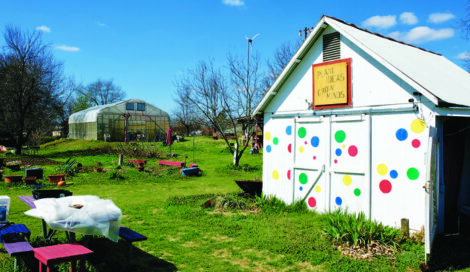Searching for examples of successful community gardens? Look no further than Dunbar Garden in Little Rock, Arkansas. Find how the community garden benefits the city and its people.
Thirty years ago, Dunbar Garden took root in a historic Little Rock, Arkansas, neighborhood. Since then, it has become a successful classroom for teaching its community about gardening and self-sufficient farming.
The community garden spans a little more than 2 acres consisting of vegetables, chickens, bees, fruit trees, a greenhouse, community composting, and a 3.7-kilowatt Skystream wind turbine spinning above it all. The garden is still going strong, even after the COVID-19 pandemic slowed things down for a while, and the community strives to provide educational resources for students and families as a top priority.
Teaching the New Generation
Many locals of Little Rock know that Dunbar Magnet Middle School was opened in 1929 as Paul Laurence Dunbar High School — named after the African American poet Paul Laurence Dunbar (1872-1906). Dunbar High School was built as a Black-only, combined middle and high school during the “separate but equal” era of education brought into effect by the Supreme Court ruling in Plessy v. Ferguson (1896) and ended by the ruling in Brown v. Board of Education (1954).

Despite systemic inequality and fewer educational resources than the white-only high school, Dunbar became a well-regarded school. In 1955, Dunbar was turned into a middle school only.
Today, Dunbar sits on one side of the community garden, and it “allows students to get out and study some aspects of planting, agriculture, and about gardening,” according to its principal, Eunice Thrasher. Most of Dunbar’s students and those from the nearby Gibbs Magnet Elementary School say they like getting outside.

They also get hands-on learning. “You learn to pick the big leaves,” sixth-grader Katelyn Cole said while working her way between rows of mustard greens. In March, the students worked the soil and planted vegetables; in May, they harvested some of the leafy plants. Now, Katelyn understands the process from planting to harvesting.
According to her teacher, Eric “Coach” Redmon, most students enjoy gardening, and they all leave the garden with a better appreciation of agriculture. “It’s hands-on learning. A lot of them connect,” he said. Redmon, who teaches middle-school environmental space and technology, explained, “They learn about the environmental system, and they learn about the food that they’re eating.”
Some of the elementary-school students learn where food comes from, before it’s sold on grocery shelves or in restaurants. They also find out that planting a garden isn’t rocket science.

Classes at the garden include lectures from Chris Wyman, who worked there from 2009 to 2015, and then returned in 2021, after working for Little Rock-based nonprofit Heifer International. “I’ve always done gardening, farm work,” he said. “I was taught by my grandparents, who grew up doing this kind of stuff. It was a big source of how they got their food. I gained that knowledge from them.”
“One of the biggest things we teach,” he continued, “is pollinator gardens and importance of bees and butterflies. It’s very cool. It’s such a hands-on experience for kids to come out and see the monarch caterpillar and possibly take it home or into the classroom and watch it metamorphosize into a butterfly and bring it back out.”
He adjusts his teaching to the ages of the students, some of whom are Boy Scouts earning their sustainability merit badges.

After one of Wyman’s lectures, 16-year-old Boy Scout Derek McAllister said the garden “was wonderful. It takes you back to a more traditional time when everybody had to help each other, and everybody is contributing to the community. It’s pretty great.”
McAllister came to earn a merit badge and left with a deeper appreciation of gardening. He’ll consider having one in his yard: “I would love that,” he said.
While the focus of the community garden is teaching, those involved with the garden have also learned a lot. That includes growing different vegetables and, for a while, even having goats — which were liked, but were too high-maintenance.
Successful Community Gardens Come from Working Together
Much of the work at Dunbar Garden is done to maintain its functionality. This falls to Wyman, who is the only paid employee there and works for 25 hours a week. He called his job a “blessing,” and he enjoys teaching and the garden work.
Wyman described the community garden as working like a functioning farm. “It’s very self-sustaining. If this was my farm, I would be able to make a living off it and feed myself.”
He shares his second home at Dunbar Garden with the volunteers who also keep it going.

Many days, you can find Don Molden potting plants in the greenhouse or tiling and weeding the soil outside. He has volunteered here since his retirement from the Arkansas National Guard in 2012. “It’s a community thing,” he said. “It’s outside, I use my hands, and it’s something to keep me busy.”
Molden’s goddaughter introduced him to the garden after her school toured it. “I’ve been here ever since,” he said. He volunteers an average of three days a week, five hours a day, but sometimes more.
Lorraine Coleman first came to the garden in 2011 for advice on growing herbs in her home garden. She liked what she saw and has been volunteering ever since. Her habit of getting people to work together earned her the nickname “Ms. Unity.” “I needed some unity,” she explained. “I decided I needed to help. When you work together, you work better.”
Adding a Wind Turbine
The self-sustaining nature of the garden extends to its wind turbine. The city pays the garden’s power bills, and in return, gets credit for the electricity produced by the wind turbine, which is more than the garden consumes. When the wind turbine was installed in June 2009, it was the first in Arkansas to use a feed-in meter, with the power generated going into the grid.
The 2.7-kilowatt Skystream wind turbine was installed to promote renewable energy. It’s the product of a partnership that included the Sierra Club and the city of Little Rock.

It’s also what got Dunbar Garden board member and former board president Sally Anderson involved with the garden. After reading about a project to install the first wind turbine in Little Rock, she volunteered to help raise the approximately $18,000 needed. Most of the funds were raised with small donations.
Funding a Sustainable Garden
In 2003, Dunbar Garden still had traditional plots kept up by individuals. The plots weren’t maintained, so they were phased out with few objections, and the focus of the community garden shifted toward education.
Funding is and has always been the biggest challenge for the community garden, according to board member and past president Sylvia Blain. “In order for this to work, you have to have paid people. We had 800 students a month coming out here. That couldn’t be done with volunteers.”

Funding also determines how many hours the city can employ people to work in the community garden. A decade ago, Wyman was one of two employees, each of whom was paid for 35 hours a week.
“The budget fluctuates. COVID definitely did a number on it,” Wyman said. “Because funding can fluctuate so much, we do have to show that this place is a sustainable entity. We raise money off produce sales and plant sales, and all of that goes back into the garden.”
Most Wednesdays, at the garden’s weekly farmers market during the growing season, the growers sell their produce rather quickly.
The greenhouse has proven very useful in this regard, Wyman notes: “For a garden this size, it would cost us a lot to buy plants, where it can cost much less to buy seeds and start our own.” Members of the community garden produce more plants than they can use, so they donate the extra plants to other community gardens.
Grants and donations are an important source of funding for the garden, since they’re used to make improvements. The concrete floor and materials for the greenhouse were funded with a grant and built with volunteer labor. The pavilion where Wyman gives lectures and people meet was donated by the Rotary Club. Another community grant funded two high tunnels, which have expanded the growing season. Currently, volunteers would like to receive funding for a composting toilet, but they’re happy to have the portable toilet provided by the city.

Bartering has also proven important. Hops grown in the community garden have been donated to local brewers, and, in turn, those brewers have sometimes donated beer for special events at the garden.
There’s also a lot of organizing involved. “It takes a village,” Anderson said. “Seven days a week, there’s something to do. It’s a lot more than people think it’s going to be.”
“There’s so much more than gardening,” she continued. “In order to sell the vegetables, you have to tell people they’re for sale. In order for classes to be done, you have to coordinate with the teachers. The events are a whole other ballgame.”
The garden falls under a special umbrella of government rules, which make running it and dealing with government ordinances easier. For instance, Dunbar Garden has a year-round burn permit, so it’s not necessary to apply for a new one each time a burn is done.
Community Garden Benefits
Parts of the land that the Dunbar Garden resides on are owned by the neighboring schools, the city, and the nearby library. These places are accommodating toward the community garden, perhaps because they see the role it plays in the community.
Dunbar Garden’s close proximity to the revitalized South Main Street area, with its bakeries, shops, galleries, and restaurants, has helped too, because many of those vendors want to buy local.
Composting is another community effort. The garden composts the grass and other dropped-off organic cuttings in piles. There are instructions on what to deliver and buckets for the organic matter. The Root Cafe delivers about 10 buckets a week. “We generate a lot of food waste. I’m glad it’s going somewhere,” said chef Jon Arrington. “I’m so glad it’s not going toward the landfill.”

The lessons learned at Dunbar Garden are passed on to other community gardens. This includes having a plan but being flexible. “Start small. Make it manageable,” Wyman said. “Utilize the resources around available to you. In the Little Rock area, there are so many of us now.” When Dunbar Garden started, it was a trailblazing community garden, but now there are far more community gardens able to help each other.
Know your community too. “It’s about knowing what people in your surrounding community might want,” Wyman said.
Now, the garden is “well-rooted” in the community, according to the current board president, Holly Wyman. Holly has been involved with the garden since 2010, and she described it as similar to Alice Waters’ Edible Schoolyard in Berkeley, California.
“This is a gem for the city of Little Rock. Now we’re part of the landscape,” said Blain, who also runs the nonprofit Potluck Food Rescue which “bridges the gap between those with too much food, and those without enough.”
After 30 years, there are now students whose parents came to Dunbar Garden when they were the same age. They don’t need to be convinced of the community garden’s value.
“Community support is absolutely important,” Chris Wyman said. “This wouldn’t exist if people didn’t want it to.” Truer words have never been spoken.
Mick Elmore has worked freelance and written for nearly 100 publications, including news agencies, newspapers, and magazines that have taken him to more than 25 countries. Now, he’s traveling around America, mostly by bicycle, and interviewing people about how his home country has changed during his 33 years away.







